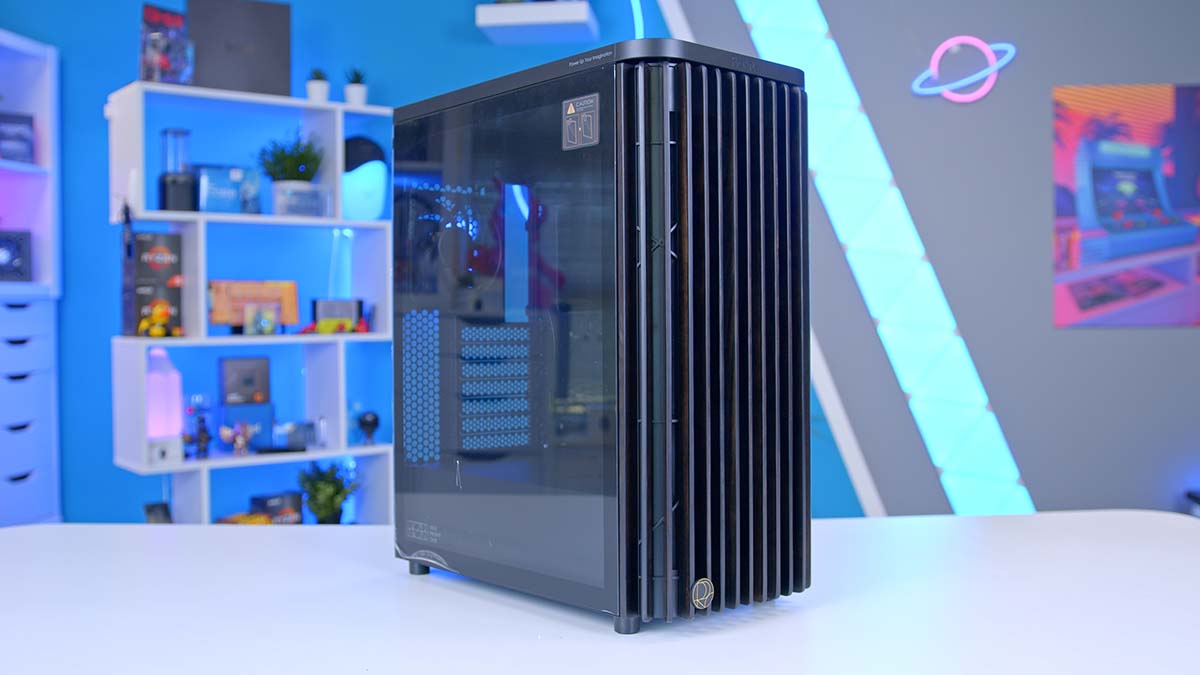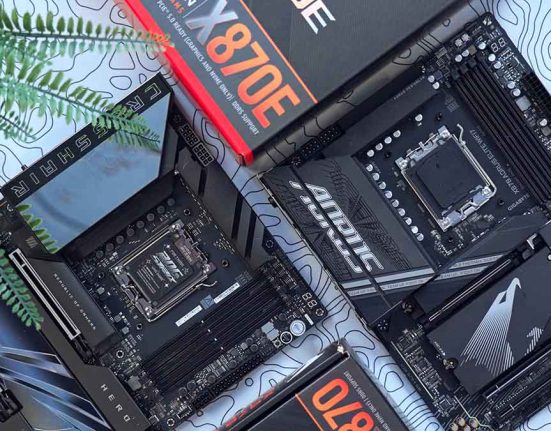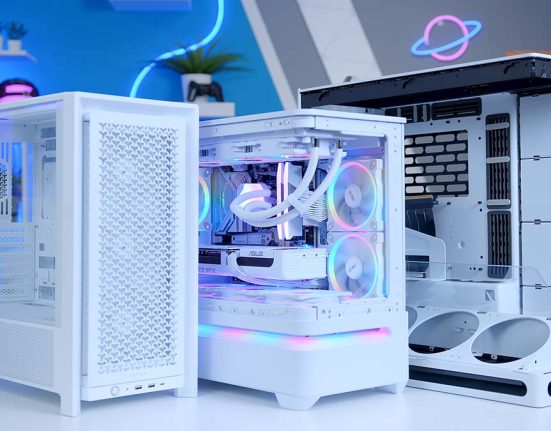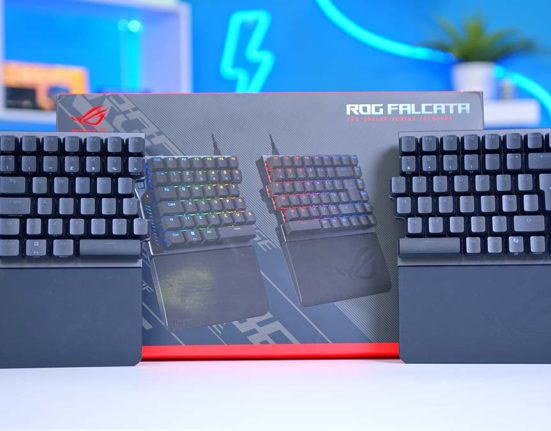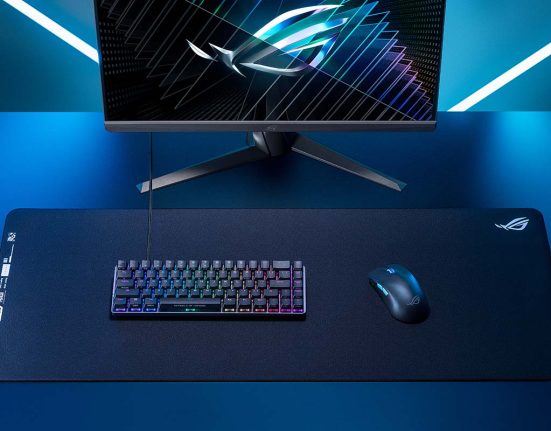The ASUS ProArt PA401 PC case is a highly sophisticated chassis aimed at enthusiasts building a PC that looks good and offers vast amounts of functionality and plenty of room for a stunning and incredibly powerful system. Equipped with a stylish wood front panel with an open grille for air intake, three pre-installed fans, builder-friendly mechanisms, and a clean aesthetic, the ProArt PA401 is designed with a vast range of prospective buyers in mind.
When picking up a PC case, it’s fairly common that you’ll have to make sacrifices on either the aesthetic or functionality to find a chassis that works for you. For example, the Antec C5 is a gorgeous white case with dual tempered glass panels showcasing the components inside, but its approach to cable management is relatively lacklustre. The King 65 Pro is another example. This is a highly functional case, but its size and lack of bottom fans often make it look pretty empty. However, the ASUS ProArt PA401 is a chassis offering the best of both worlds: a gorgeous aesthetic and a versatile and robust design that’s easy to build.
In this review article, we’ll examine the ASUS ProArt PA401 in depth, examining the specs, design, build quality, and features to determine whether this rather fanciful case is a strong competitor or just for show.
Specification
The ASUS ProArt PA401 has interesting specs. The most obvious thing to note is that this is a traditional mid-tower. Dual-chamber cases have been all the rage, with the arrival of chassis like Lian’s O11D range and Montech’s King 95 and King 65 models. However, ASUS has opted for a traditional ATX mid-tower approach, which shouldn’t encroach on desk space versus a much more sizeable dual-chamber chassis.

Regarding the IO, the ProArt PA401 offers a relatively basic set of ports that you’ll find on other similarly priced cases. There are three USB ports: one USB 3.2 Gen2 Type-C and two USB 3.2 Gen1 Type-A ports. While it would be nicer to see a wider selection of ports, especially as this is a ProArt case, based on the affordable pricing, this isn’t a deal-breaker.
| Specification | ASUS ProArt PA401 |
|---|---|
| Form Factor | Mid-Tower |
| Motherboard Support | Micro-ATX, ATX |
| Case Dimensions (L x W x H) | 412mm x 225mm x 503mm |
| Front IO | 1 x USB 3.2 Gen2 Type-C 2 x USB 3.2 Gen1 Type-A 1 x 3.5mm Combo Jack |
| PCI-E Slots | 7 |
| Colour | Black |
| Max Clearance | 170mm Cooler Height 315mm GPU Length 170mm PSU Length |
| Drive Support | Up to 4 x 2.5 inch Up to 2 x 3.5 inch |
| Fan Support | Front: 2 x 160mm Top: 2 x 140mm Rear: 1 x 120mm |
| Radiator Support | Top: Up to 240mm |
| Pre-Installed Fans | 3 |
Regarding clearances, the ProArt PA401 has space for graphics cards up to 315mm long and CPU coolers up to 170mm tall. The GPU clearance is worth highlighting, as this is likely to be an issue for some gamers. If you’ve got a long card (which many of the RTX 5000 and RX 9000 GPUs are), it probably won’t fit inside this chassis. This will be a deal-breaker for those upgrading to the latest generation of cards.
Cooling support is also another area that isn’t particularly strong. While the inclusion of three pre-installed fans is nice, there’s only space for a 240mm radiator at the top or two 140mm fans. There’s no bottom or side mounting. Again, I don’t think this will be a deal-breaker, especially as the chassis comes with fans straight out of the box. But if you want to upgrade, your options will be pretty limited.
ASUS ProArt PA401 Design
At first glance, the ProArt PA401 case is very spiffy-looking. The wood panel at the front stands out in particular, as it’s one of the few cases on the market to offer a non-glass or metal panel. This resembles the Fractal Design North and the Antec C8 Wood that have hit the shelves over the past few years. I’m a big fan of the look, as it’s quite unique compared to the vast majority of options out there.
ASUS notes that the wood panel underwent a six-stage process to protect the wood from heat, humidity, and insects while providing a glossy finish. All of the wood was also sustainably sourced, which has been certified by the FSC. This is a lovely touch, as ASUS has gone the extra mile to ensure this is a premium product that doesn’t negatively impact the environment.

Behind the wood grain panel, you’ll find two 160mm fans pulling in cool air. It’s not typical for a case to utilise 160mm fans, primarily because customisation tends to go out of the window due to 160mm fans being relatively niche. However, larger fans provide more airflow and spin slower, resulting in a cooler and quieter experience. Additionally, the outer ring connecting the fans reduces vibration, furthering the point that this case is built for near-silent operation.

You’ll spot a tempered glass panel as we move around to the side. This provides a window into the build to show off the components inside. If you’ve prioritised picking ProArt components, these will pair nicely with the PA401 case. Alternatively, ASUS provides a metal side panel version that offers better durability for the case. Those who aren’t worried about aesthetics will likely want to secure the metal side panel variant.
There’s not a huge amount to cover regarding the internals. The motherboard tray and the rest of the metal on the inside of the case has a matte black finish, which helps other dark components blend in. I’m a fan of the darker look; it looks and feels much more sophisticated than some of the more gamer-focused chassis out there.

The rear of the case has some interesting qualities to touch upon. The first is the cable management clips towards the left side. These offer a way to tidy up your external power cables, such as the kettle lead for the PC, any display inputs, and even USBs. This is a nice quality-of-life feature, but its use case will entirely depend on the positioning of your setup. You may not have cable slack to feed and channel them up through the clips, so this isn’t guaranteed to work for everyone.

The second feature is the rear detachable bracket covering the power supply shroud. This bracket can easily be unscrewed, allowing builders to slide in a power supply directly from the back instead of through the side. This is a more convenient way to install the PSU, but it also minimises the risk of the case scratching the PSU or damaging some of the cables.

After removing the opposing side panel, this opens up the chamber for all of your cables and wiring. Admittedly, cable management, in this case, is likely to be a bit of a challenge. There are only a few mounting points for cable ties, and because this chamber doesn’t have a considerable amount of clearance before the side panel needs to go on. This means you’ll have to minimise bulge and be careful where there’s a large bulk of wires in a concentrated area.

Again, there are a couple of interesting design qualities in this case worth touching on. Towards the bottom right of this chamber is a tool-less 3.5-inch HDD bay, allowing you to install any SATA drive easily. At the top left is a PWM fan hub with five headers. This frees up headers on your motherboard, allowing you to install more cooling accessories.

Lastly, there is the front IO. There are three USB ports here, but there are a couple of extra buttons and toggles. On the left is a button for fan speed control, which allows you to manually or automatically adjust speeds for relaxed and intense workloads.

A small toggle on the right locks and unlocks the reset and power buttons. I can’t see many scenarios where this toggle is handy, but it will be worth using if you want to avoid accidentally pressing either of these buttons.

Building in the ASUS ProArt PA401
The ProArt PA401’s specs and design are excellent, but the principal way to determine whether a case is worth buying is by building a PC in it. We’ve built a complete system inside this case, showcasing its various qualities and building versatility.
Internal Space
Internal space inside the ASUS ProArt PA401 is arguably one of its most significant weaknesses. The PA401 can house ATX and Micro-ATX motherboards without space for small or larger form factor boards. There’s only room for a 240mm radiator at the top of the case and graphics cards up to 315mm long. Immediately, this rules out a pretty significant subset of options, as you’re restricted to just ATX, Micro-ATX motherboards and reasonable-sized GPUs.
While I can understand to a degree that ASUS might be trying to pigeonhole builders into adhering to a specific aesthetic, this will be a deal-breaker for many builders. One of the greatest things about building your own PC is freedom of choice, so I can imagine there will be many builders this chassis doesn’t appeal to based on this factor alone.
Getting the motherboard and graphics card into the case was straightforward. You slide the panel off after releasing the latch mechanism and start screwing things down. The ProArt PA401 comes with a set of motherboard screws, so it’s just a case of lining it up with the standoffs and using the supplied screws to secure it in place.
Getting the graphics card safely secured was, again, straightforward. You’ve got a relatively limited amount of space, but if your GPU is 315mm long or below, it’s simple to slot it into the motherboard and then screw it in.

As we’ve already alluded to, cable management could be improved. The lack of anchor points in this area of the case will make securing some of the wires quite complex, and the small amount of clearance will make management tricky. We recommend putting as much of the additional PSU cable slack into the power supply chamber as possible to avoid bulging.
Radiator and Fan Mounting
Again, the options for radiator and fan mounting could be improved. Unfortunately, you’re pretty limited when it comes to liquid cooling support, as there’s only one spot to install an AIO (all-in-one), which is the top panel. Additionally, this panel only supports a 240mm liquid cooler at maximum, so the strength of the cooler is immediately limited straight out of the gate, as there’s no space for a 280mm or 360mm liquid cooler.

None of the other panels officially support a liquid cooler around the rest of the case, so options are limited. The PA401 is slightly better in terms of fan support, but only to a degree. The front and rear panels come with pre-installed fans (two 160mm at the front and one 120mm at the rear), so the only extra space for fans is the top panel. There’s room here for two 140mm or two 120mm fans, which is not much.
I would prefer if the case were wider to accommodate a 360mm cooler. Considering the ProArt brand is geared towards workstations, it’s likely that if you’ve picked up a high-end CPU, you’ll want a 360mm AIO to ensure thermals are kept at bay. Additionally, this would alleviate the GPU clearance problem, providing more room for a larger graphics card and potentially a front-mounted liquid cooler as well.
Features We Like
User-Friendly Design
The ASUS ProArt PA401 case is designed to make building a PC simple and carefree. It offers an array of features, some tool-less and others providing more of a quality-of-life approach. For example, a PWM hub at the rear of the case supports five fans and a detachable PSU bracket that allows you to slide your power supply in from the rear.

There are locking buttons at the top of the case to prevent accidental presses of the reset or power button, along with a button that controls the speed of the fans. The rear cable clips help keep everything tidy, and there’s also a latched side panel with a locking mechanism. This is a feature that I’m a massive fan of, as it ensures the glass panel is safe. Seeing a glass panel held in with just a pop-out mechanism is constantly worrying, so this minimises the risk of your glass panel breaking or sustaining damage.
Gorgeous Aesthetic
If there’s one thing I’m sure of about this case, the ProArt PA401 is absolutely gorgeous. The wood panelling on the front provides another dimension to the design, and the well-ventilated matte black chassis oozes sophistication. This case is a glorious showpiece and will be a spectacle in your designated gaming room or workspace.

Features We Don’t Like
Restrictive Component Choices
Because of the various clearances across the case, it’s clear that building a PC inside this chassis will have its limits. For example, you have to choose an ATX or Micro-ATX motherboard; there isn’t support for Mini-ITX or E-ATX. There is limited space for additional fans and only one location to mount a liquid cooler, which is restricted to 240mm at the maximum.
Cable Management Space
Suppose you’re like me and prefer to organise all cables and wires so they’re out of sight and tidy; this case might not be for you. It’s possible to manage cables well in most modern chassis, but some are much tougher than others, and the ProArt PA401 unfortunately falls into the ‘difficult’ category. There’s limited clearance at the back of the case, which means you’ll have to minimise bulge so that the panel will go back on.

But because of the case’s design, there’s not much space to cram in any additional cable slack other than in the PSU chamber, which can result in suppressed airflow and weaker thermals. If you want a quick and easy approach to cable management, it’ll be worth looking at alternative cases.
Conclusion
ASUS ProArt PA402

Product Name: ProArt PA402
Brand: ASUS
-
Features
-
Design
-
Versatility
-
Value For Money
Summary
The ASUS ProArt PA401 is one of the best-looking cases that we’ve seen in quite some time. ASUS has gone the extra mile to provide an incredibly premium and sophisticated chassis that won’t break the bank. This case offers a sustainably sourced wooden front panel, providing a unique look and some depth to the aesthetic. The chassis offers a matte black finish with plenty of ventilation to ensure air flows appropriately, cooling the components inside. There are many quality-of-life features, such as an integrated PWM hub, fan control button, and locking mechanism for the tempered glass panel, that make this case reasonably straightforward to build with. Additionally, I was surprised to find that as a ProArt product, the PA401 isn’t ridiculously expensive, further amplifying this case’s value proposition.
However, there are some pretty notable caveats to be aware of. The first is component support. The ProArt PA401 has limited space, so your choice of liquid cooler, graphics card, and even motherboard will be restricted. However, this won’t be a deal-breaker for everyone, primarily if you aim to build a PC with predominantly ProArt components. Furthermore, cable management is tight. This chassis doesn’t offer much support for good cable management, which means you may have to think out of the box a bit when it comes to tidying up the wires in this case.
Pros
✅ Gorgeous aesthetic
✅ Ample quality-of-life features
✅ Sustainably sourced wood panel
Cons
❌ Restrictive component options
❌ Tight cable management space
❌ Doesn’t support large GPUs


